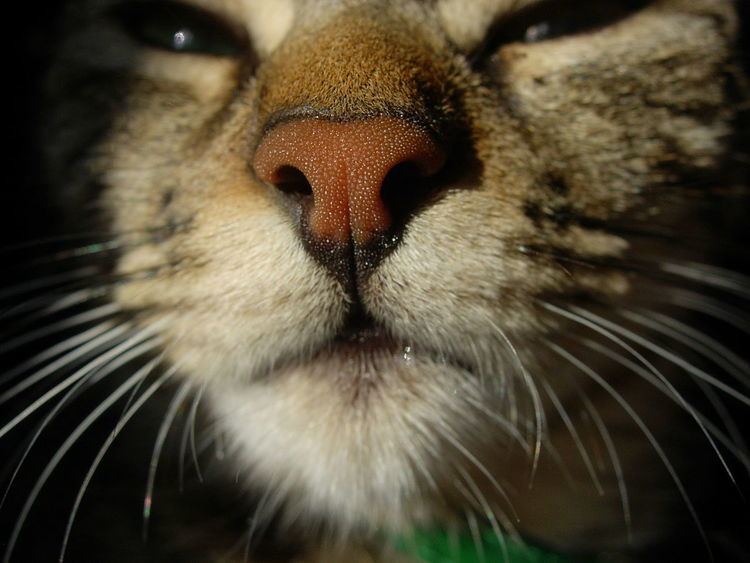 | ||
The rhinarium (New Latin, "belonging to the nose"; plural: rhinaria) is the naked skin surface surrounding the external openings of the nostrils in most mammals. In common usage, for example among breeders of cats or dogs, the standard term is nose leather. More informally people may speak of a "wet snout" or "wet nose" because its surface commonly is moist in a healthy cat or dog.In many species there is a philtrum, a groove down the middle.
Contents
The study of the structure and of its associated functions has proved to be of considerable importance in mammalian evolution and taxonomy.
In an analogous connection of no relevance to vertebrate morphology, the term rhinarium sometimes is applied to chemosensory structures in invertebrates. For example, microscopic sensilla in the form of flattened sense organs on the antennae of aphids are referred to as rhinaria.
Morphology
Morphologically the rhinarium certainly is part of the olfactory system, but it still is open to debate which part of the system it derived from. On the one hand it might be part of the main olfactory system, which captures media-borne odors; on the other, it might be part of the "second nose", the Accessory Olfactory System, which samples chemicals dissolved in fluids. An example of the former view is that the rhinarium is "an outward extension of the olfactory ... skin that covers the nasal passages, [which] contains nerve receptors for smell and touch." If that interpretation is correct, and the rhinarium extends the olfactory epithelium that lines the nasal passages, then the rhinarium is part of the main system.
In an opposing view, the philtrum ideally traces a path that continues over a notch in the upper lip, through a gap between the first incisors and premaxillae, along a "midline palatal groove" to "a canal that connects with the duct of the vomeronasal organ," part of the accessory system. Where on the one hand the moisture (mucus) may have trapped odiferous molecules in the medium, on the other hand it may be the remnant of a fluid transmission system for molecules of pheromones.
Typically the rhinarium is crenellated (wrinkled or embossed), which, as a generalisation has been speculated to increase its sensory area, but there are many exceptions and variations among different mammalian taxa, and also variations in its innervation and sensilla, so it is appropriate to treat generalisations with caution in this matter.
Function
Mammals with rhinaria tend to have more acute sense of smell, and the loss of the rhinarium in the haplorrhine primates is related to their decreased reliance on olfaction, being associated with other derived characteristics such as a reduced number of turbinates. The rhinarium is very useful to animals with good sense of smell because it acts as a wind direction detector. The cold receptors in the skin respond to the place where evaporation is the highest. Thus the detection of a particular smell is associated with the direction it came from.
The rhinarium is adapted for different purposes in different mammals according to ecological niche. In aquatic mammals, development of lobes next to the nostrils allow them to be closed for diving. In mammals that dig or root with their noses, the rhinarium often develops into a resilient pad, with the nostrils off to the side or below, and capable of closing for exclusion of dust. Examples include the common wombat, marsupial mole, and members of the Chrysochloridae. In the elephants it has become a tactile organ. In the walrus, it is covered with stiff bristles to protect it during foraging for shellfish. In many animals the form and purpose of the rhinarium remains to be elucidated.
The evolutionary pressures also are not always clearly distinguishable and there have been upheavals in late 20th and early 21st century taxonomy. For example, the lack of an obvious rhinarium in Tarsiiformes has been suggested to be the consequence of the enormous development of the eyeballs, rather than a loss of relevance of olfaction., but the significance is currently debatable, because there currently is an influential body of opinion favouring inclusion of the tarsiers in the Haplorhini rather than in the Strepsirrhini as had been traditional.
Mammalian taxonomy in general
The rhinarium is a general mammalian feature and therefore is likely to have been present in the proto-mammal stage.
Primate taxonomy
Primates are phylogenetically divided into Strepsirrhini, and the Haplorhini. The Strepsirrhini, which means "twisted-nosed", are primates with rhinaria, which is the ancestral condition. The Strepsirrhini consists of the prosimians: the lorises, and the lemurs. The Haplorhini, which means "simple-nosed", are primates which have replaced the rhinarium with a more mobile, continuous, dry upper lip. The Haplorhini consists of the Simians: the monkeys, the apes, and humans.
Prior to 2013, taxonomy ignored the fact that tarsiers have no rhinarium when placing them in the Strepsirrhini. However, since then the tarsiers have been placed in with the Haplorhini, and thus the absence of a rhinarium became diagnostic of the Haplorhini.
